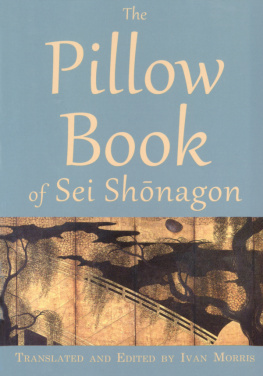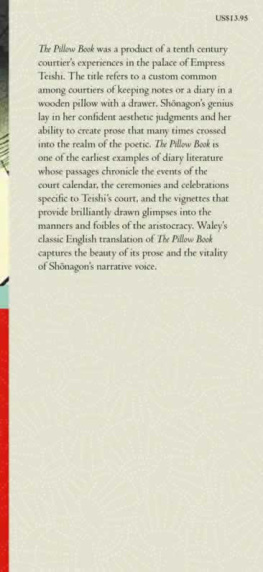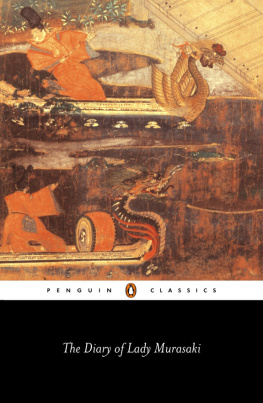Table of Contents
THE PILLOW BOOK OF SEI SHNAGON
TRANSLATIONS FROM
THE ASIAN CLASSICS
THE PILLOW BOOK OF SEI SHNAGON
TRANSLATED AND EDITED BY IVAN MORRIS
COLUMBIA UNIVERSITY PRESS
NEW YORK
Columbia University Press
New York Chichester, West Sussex
cup.columbia.edu
Copyright 1991 Columbia University Press
All rights reserved
EISBN 978-0-231-54923-3
Library of Congress Cataloging-in-Publication Data
Sei Shnagon, db. ca. 967.
[Makura no sshi. English]
The pillow book of Sei Shnagon translated and edited by Ivan Morris.
p. cm.(Translations from the Asian Classics)
Translation of: Makura no sshi.
ISBN 978-0-231-07337-0 (pbk.)
I. Morris, Ivan I.
II. Title.
III. Series.
PL788.6.M3E56 1991
895.68107dc20
91-15757
CIP
A Columbia University Press E-book.
CUP would be pleased to hear about your reading experience with this e-book at .
This translation is dedicated to my friend and colleague Professor Donald Keene
CONTENTS
Sei Shnagon is among the greatest writers of prose in the long history of Japanese literature; The Pillow Book is an exceedingly rich source of information concerning the halcyon period in which she lived. Yet about her own life we have almost no definite facts. She was born approximately a thousand years ago (965 is a likely date) and served as lady-in-waiting to Empress Sadako during the last decade of the tenth century. Her father, whether real or adoptive, was Motosuke, a member of the Kiyowara clan, who worked as a provincial official but was best known as a scholar and a poet. It is possible, though I think unlikely, that Shnagon was briefly married to a government official called Tachibana no Norimitsu, by whom she may have had a son. Her life after her service ended is totally obscure. There is a tradition that she died in lonely poverty; but this may be the invention of moralists who, shocked by her worldly approach and promiscuous doings, ascribed to her last years a type of retribution that occurs more often in fiction than in reality.
Of Shnagons relations with her family nothing is known, and she mentions her father only once; we have no idea where or how she lived when not at Court, nor when or where she died. Even her name is uncertain: in the palace she was called Shnagon (Minor Counsellor), but recent research suggests that her real name may have been Nagiko; Sei refers to the Kiyowara family.
There is an acidulous reference to Sei Shnagon in the diary of her great contemporary, Murasaki Shikibu, the author of The Tale of Genji:
Sei Shnagon has the most extraordinary air of self-satisfaction. Yet, if we stop to examine those Chinese writings of hen that she so presumptuously scatters about the place, we find that they are full of imperfections. Someone who makes such an effort to be different from others is bound to fall in peoples esteem, and I can only think that her future will be a hard one. She is a gifted woman, to be sure. Yet, if one gives free rein to ones emotions even under the most inappropriate circumstances, if one has to sample each interesting thing that comes along, people are bound to regard one as frivolous. And how can things turn out well for such a woman?
This is almost our only information about Sei Shnagon except what is revealed by The Pillow Book itself. A vast collection of personal notes, her book covers the ten-odd years during which she served at Court, and reveals a complicated, intelligent, well-informed woman who was quick, impatient, keenly observant of detail, high-spirited, witty, emulative, sensitive to the charms and beauties of the world and to the pathos of things, yet intolerant and callous about people whom she regarded as her social or intellectual inferiors.
Shnagon wrote during the great mid-Heian period of feminine vernacular literature that produced not only the worlds first psychological novel, The Tale of Genji, but vast quantities of poetry and a series of diaries, mostly by Court ladies, which enable us to imagine what life was like for upper-class Japanese women a thousand years ago. In many ways, such as her love of pageantry and colour, her delight in poetry, her mixture of naivety and sophistication, she resembled the other women writers we know. But The Pillow Book also suggests some notable differences. Shnagons scorn for the lower orders, which has moved one indignant Japanese critic to describe her as a spiritual cripple, and her adoration of the Imperial family were so pronounced as to seem almost pathological. Her attitude to men, even to those of a somewhat higher class than hers, was competitive to the point of overt hostility. And, partly owing to this combative spirit, her writing is free of the whining, querulous tone that often marks the work of her female contemporaries when they describe their relations with men.
In a section of The Pillow Book that can be dated about 994 Shnagon writes:
One day Lord Korechika, the Minister of the Centre, brought the Empress a bundle of notebooks. What shall we do with them? Her Majesty asked me. The Emperor has already made arrangements for copying the Records of the Historian.
Let me make them into a pillow, I said.
Very well, said Her Majesty. You may have them.
I now had a vast quantity of paper at my disposal, and I set about filling the notebooks with odd facts, stories from the past, and all sorts of other things, often including the most trivial material. On the whole I concentrated on things and people that I found charming and splendid; my notes are also full of poems and observations on trees and plants, birds and insects.
It is uncertain whether this passage is authentic; yet no doubt Shnagon started her book while still serving in the Court whose life she describes with such minute detail. We know that some of the sections were written many years later than the events they record, and the work was not completed until well after Shnagons retirement following the Empresss death in 1000.
Though this is the only collection of its type to have survived from the Heian period, it is possible that many others were written. Of the dozen or so works of prose fiction she lists in her book only one has come down to us; Heian miscellanies like












